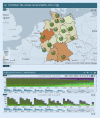[The German Network of University Medicine: technical and organizational approaches for research data platforms]
- PMID: 36688978
- PMCID: PMC9870206
- DOI: 10.1007/s00103-022-03649-1
[The German Network of University Medicine: technical and organizational approaches for research data platforms]
Abstract
The Network University Medicine (NUM) consists of 36 university clinics in Germany. It was set up to coordinate COVID-19 university medicine research activities on a national level. This required, among other things, common infrastructures for the collection, storage, and use of medical research data. These infrastructures were not available in the required form when the NUM started in April 2020. Medical research data are extremely heterogeneous and reach far beyond "real world data" from patient care. There was no "one size fits all" solution, so NUM built five infrastructures for different types of data, different ways of obtaining data, and different data origination settings. To prevent the creation of new data silos, all five infrastructures operate based on FAIR principles (findable, accessible, interoperable, reusable). In addition, NUM is implementing an overarching governance framework to manage the evolution of these five infrastructures. The article describes the current state of development and possible perspectives with a strong focus on technical and organizational aspects.
Das Netzwerk Universitätsmedizin (NUM) besteht aus den 36 Standorten der Universitätsmedizin in Deutschland. Der Auftrag ist die Koordinierung der universitätsmedizinischen COVID-19-Forschung auf nationaler Ebene. Dazu werden u. a. gemeinsame Infrastrukturen für die Sammlung, Haltung und Nutzung medizinischer Forschungsdaten benötigt. Diese standen beim Start des NUM-Projekts im April 2020 nicht im erforderlichen Rahmen zur Verfügung. Medizinische Forschungsdaten sind extrem heterogen und gehen weit über „Real World Data“ (Daten aus dem Versorgungsalltag) hinaus. Eine universelle Lösung dafür gab es nicht, deshalb hat das NUM fünf Forschungsinfrastrukturen für unterschiedliche Datenarten, unterschiedliche Wege der Datengewinnung und unterschiedliche Datenentstehungssettings aufgebaut. Um die Bildung neuer Datensilos zu verhindern, arbeiten alle fünf Infrastrukturen auf Basis der FAIR-Prinzipien, nach denen Daten auffindbar (findable), zugänglich (accessible), interoperabel (interoperable) und wiederverwendbar (reusable) sein sollen. Zudem implementiert das NUM einen übergreifenden Steuerungsrahmen (Governance Framework), um die Weiterentwicklung dieser fünf Infrastrukturen zentral zu steuern. Der Artikel beschreibt den aktuellen Stand der Infrastrukturentwicklung im NUM und mögliche Perspektiven. Ein starker Fokus wird dabei auf die technisch-organisatorischen Grundlagen gerichtet.
Keywords: COVID-19; Database; FAIR Data Principles; Pandemic Preparedness; Research Infrastructure.
© 2023. The Author(s).
References
-
- Horn A, Krist L, Lieb W, et al. Long-term health sequelae and quality of life at least 6 months after infection with SARS-CoV-2: design and rationale of the COVIDOM-study as part of the NAPKON population-based cohort platform (POP) Infection. 2021;49:1277–1287. doi: 10.1007/s15010-021-01707-5. - DOI - PMC - PubMed
Publication types
MeSH terms
LinkOut - more resources
Full Text Sources
Medical
Miscellaneous







